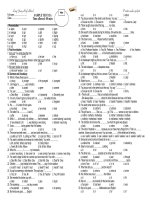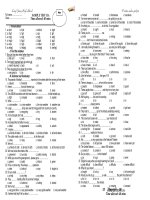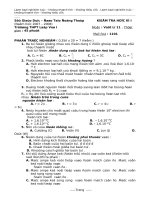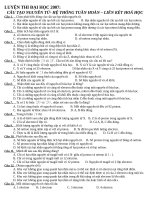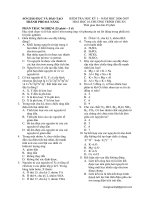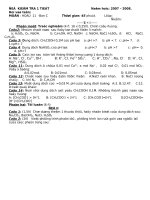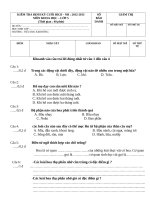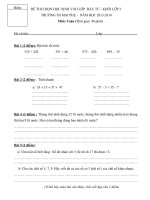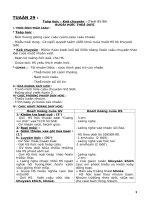Exchange traded funds (ETFs) (2007)
Bạn đang xem bản rút gọn của tài liệu. Xem và tải ngay bản đầy đủ của tài liệu tại đây (3.83 MB, 303 trang )
01_04358X ffirs.qxp
12/4/06
4:02 PM
Page iii
Getting Started in
EXCHANGE
TRADED
FUNDS
(ETFs)
Todd Lofton
01_04358X ffirs.qxp
12/4/06
4:02 PM
Page vi
01_04358X ffirs.qxp
12/4/06
4:02 PM
Page i
Getting Started in
EXCHANGE
TRADED
FUNDS
01_04358X ffirs.qxp
12/4/06
4:02 PM
Page ii
The Getting Started In Series
Getting Started in Online Day Trading by Kassandra Bentley
Getting Started in Asset Allocation by Bill Bresnan and Eric P. Gelb
Getting Started in Online Investing by David L. Brown
and Kassandra Bentley
Getting Started in Investment Clubs by Marsha Bertrand
Getting Started in Stocks by Alvin D. Hall
Getting Started in Mutual Funds by Alvin D. Hall
Getting Started in Estate Planning by Kerry Hannon
Getting Started in 401(k) Investing by Paul Katzeff
Getting Started in Internet Investing by Paul Katzeff
Getting Started in Security Analysis by Peter J. Klein
Getting Started in Global Investing by Robert P. Kreitler
Getting Started in Futures by Todd Lofton
Getting Started in Financial Information by Daniel Moreau
and Tracey Longo
Getting Started in Technical Analysis by Jack D. Schwager
Getting Started in Hedge Funds by Daniel A. Strachman
Getting Started in Options by Michael C. Thomsett
Getting Started in Real Estate Investing by Michael C. Thomsett
and Jean Freestone Thomsett
Getting Started in Annuities by Gordon M. Williamson
Getting Started in Bonds by Sharon Saltzgiver Wright
01_04358X ffirs.qxp
12/4/06
4:02 PM
Page iii
Getting Started in
EXCHANGE
TRADED
FUNDS
(ETFs)
Todd Lofton
01_04358X ffirs.qxp
12/4/06
4:02 PM
Page iv
Copyright © 2007 by Todd Lofton. All rights reserved.
Published by John Wiley & Sons, Inc., Hoboken, New Jersey.
Published simultaneously in Canada.
No part of this publication may be reproduced, stored in a retrieval system, or transmitted in any form or by
any means, electronic, mechanical, photocopying, recording, scanning, or otherwise, except as permitted under Section 107 or 108 of the 1976 United States Copyright Act, without either the prior written permission
of the Publisher, or authorization through payment of the appropriate per-copy fee to the Copyright Clearance Center, Inc., 222 Rosewood Drive, Danvers, MA 01923, (978) 750-8400, fax (978) 646-8600, or on
the web at www.copyright.com. Requests to the Publisher for permission should be addressed to the Permissions Department, John Wiley & Sons, Inc., 111 River Street, Hoboken, NJ 07030, (201) 748-6011, fax
(201) 748-6008, or online at />Limit of Liability/Disclaimer of Warranty: While the publisher and author have used their best efforts in
preparing this book, they make no representations or warranties with respect to the accuracy or completeness
of the contents of this book and specifically disclaim any implied warranties of merchantability or fitness for
a particular purpose. No warranty may be created or extended by sales representatives or written sales materials. The advice and strategies contained herein may not be suitable for your situation. You should consult
with a professional where appropriate. Neither the publisher nor author shall be liable for any loss of profit
or any other commercial damages, including but not limited to special, incidental, consequential, or other
damages.
For general information on our other products and services or for technical support, please contact our Customer Care Department within the United States at (800) 762-2974, outside the United States at (317)
572-3993 or fax (317) 572-4002.
Wiley also publishes its books in a variety of electronic formats. Some content that appears in print may
not be available in electronic books. For more information about Wiley products, visit our web site at
www.wiley.com.
Library of Congress Cataloging-in-Publication Data:
Lofton, Todd.
Getting started in exchange traded funds (EFTs) / Todd Lofton.
p. cm.
Includes bibliographical references and indexes.
ISBN-13: 978-0-470-04358-5 (pbk.)
ISBN-10: 0-470-04358-X (pbk.)
1. Exchange traded funds. 2. Stock index futures. I. Title.
HG6043.L64 2007
332.632'7—dc22
2006023049
Printed in the United States of America.
10 9 8 7 6 5 4 3 2 1
01_04358X ffirs.qxp
12/4/06
4:02 PM
Page v
In memory of our loving son, David
01_04358X ffirs.qxp
12/4/06
4:02 PM
Page vi
02_04358X ftoc.qxp
12/5/06
8:34 AM
Page vii
Contents
Preface
Acknowledgments
ix
xiii
Chapter 1
A Seagull’s View of an Exchange-Traded Fund
1
Chapter 2
The Genealogy of the Exchange-Traded Fund
3
Chapter 3
Mustering a Retirement Fund
9
Chapter 4
How Exchange-Traded Funds Are Created
13
Chapter 5
Shopping for an Exchange-Traded Fund
19
Chapter 6
Pork Bellies Don’t Fit in a Safe Deposit Box
37
Chapter 7
Position Management
41
Chapter 8
Price Forecasting Using Fundamental Analysis
vii
49
02_04358X ftoc.qxp
12/5/06
8:34 AM
Page viii
CONTENTS
viii
Chapter 9
Technical Analysis
55
Chapter 10
The Tuesday Investors
83
Chapter 11
Futures Contracts on Exchange-Traded Funds
87
Chapter 12
Options on Exchange-Traded Funds
99
Chapter 13
Day Trading
115
Chapter 14
A Very Short Word about Taxes
129
Chapter 15
An ETF Menu
131
Chapter 16
The Underlying Indexes
139
Appendix A
A Gallery of Exchange-Traded Funds
165
Appendix B
Where to Find More Information
269
Glossary
Bibliography
Index
275
281
283
03_04358X fpref.qxp
12/5/06
8:31 AM
Page ix
Preface
Welcome to a unique new way to invest.
To answer your first question, an exchange-traded fund is a basket
of stocks that duplicate a stock index, such as the S&P 500 or Dow
Jones. The basket trades on the exchange as a single stock.
This arrangement gives an exchange-traded fund (ETF) special
qualities. For one thing, because an ETF represents the stocks of several
different companies, it carries less risk than a share of stock in just one
company.
ETFs can be bought and sold throughout the trading day. They can
be shorted, bought on margin, and traded with stop and limit orders.
They are passively managed, so they have much lower turnover and
smaller expenses than actively managed funds.
ETFs also have few taxable capital gains and good transparency.
(You can see what you’re buying.) There is no minimum investment, and
there are no fees or sales charges; the only transaction costs are normal
brokerage commissions.
Should you consider having one or two ETFs in your stock account? Yes, especially if you are a relatively farsighted investor. But to decide that, you will have to know more about them, and that is where this
book comes in. Here you will learn how ETFs are created, what part they
can play in your investments, what ETFs are out there, and how to find
one that meets your personal financial goals.
The First Pool Man The idea of enabling a small investor to own a
large portfolio is not new. The first investment trust dates from the mid18th Century in Europe, when a Dutch financier named Adriaan Van
Ketwich pooled the money of 37 individual investors and bought a large
group of European government bonds.
Adriaan’s fund was successful, and other funds followed, in the
Netherlands and later in England. Investment trusts began to appear in
03_04358X fpref.qxp
x
12/5/06
8:31 AM
Page x
PREFACE
the United States in the late 1800s; a landmark fund, the Massachusetts
Investment Trust, was founded at Harvard University on March 21,
1924.
The first index mutual fund was introduced on August 31, 1976. It
was unique in that its returns did not depend on the fortunes of a money
manager. The mutual fund’s stock portfolio duplicated the S&P 500
Stock Index, and its returns equaled the returns of the index.
Seventeen years later, in 1993, the first exchange-traded fund began
trading on the American Stock Exchange. Named the S&P Depositary
Receipt (SPDR) Trust Series 1, it too tracked the S&P 500 Index.
As interest in ETFs has grown, so has their number. As of late 2006,
there are 293 ETFs traded on U.S. exchanges, representing some $320
billion in total assets. They are benchmarked to many different indexes,
including stock indexes, fixed-income indexes, real estate indexes, a commodity index, the price of gold bullion, the price of silver, the price of
crude oil, and the exchange rate of foreign currencies.
Putting ETFs to Work for You There are several possible uses for
ETFs:
• A broad-based ETF can be employed as the core of a portfolio; a
foundation for other, shorter term, more risky pursuits undertaken in an attempt to increase returns. The ETF helps ensure
that the portfolio’s overall performance does not differ markedly
from the investor’s long-term goals.
• An ETF can be used as a temporary parking spot for cash. It is
freely bought and sold for nominal transaction costs.
• If you want to set a certain investment benchmark—e.g., a diverse portfolio of midcap value stocks—it is much more convenient and less costly to buy, say, the iShares Russell Midcap Value
Index Fund than to sort through and buy a large number of individual stocks.
• A broad-based ETF can be used for short-term trading. It is liquid, and its diversity virtually eliminates any unpleasant surprises
resulting from single-stock risk.
• ETFs enable you to participate in markets that might not otherwise be available to you, such as foreign stocks or commodities.
03_04358X fpref.qxp
12/5/06
8:31 AM
Page xi
Preface
xi
What to Expect This book tells you what you need to know. It shows
you how ETFs are created. It dissects risk. It points out what to look for
when you are considering buying an ETF.
It explains the different styles of ETFs and how the different styles
have fared over the years. It gives you a quick guide to futures contracts
on ETFs. Same for put and call options on ETFs.
We show you several ways to forecast ETF prices. We demonstrate
how to use ETFs for hedging.
We also provide you with help for day-to-day buying and selling;
such as, what kind of order to use in a given market situation, how to
deal with an unrealized loss, the safest way to add to a winning position.
Online access and single-digit trading commissions have made
very-short-term trading feasible. If you are interested in traveling in the
fast lane, we’ll show you how to start your engine.
Easy Reader You’ll find this book very easy to read. There’s little theory, no jargon, and only a sprinkling of math. Sentences are short and
sweet, and there are plenty of everyday examples to make sure that you
understand. When you’ve finished reading, you’ll be able to approach the
subject of exchange-traded funds with confidence.
This book is written from the point of view of a trader, by one who
was a member and floor broker on the Chicago Board Options Exchange
for a number of years.
When it comes time for you to find a suitable ETF, the trail begins
in Chapter 15, which lists the ETFs and the indexes that they track. The
next stop is Chapter 16, where you’ll find a description of the index behind the ETF. If you still like what you see, Appendix A contains a miniprospectus for almost every ETF traded today, arranged alphabetically by
trading symbol.
03_04358X fpref.qxp
12/5/06
8:31 AM
Page xii
04_04358X flast.qxp
12/4/06
4:03 PM
Page xiii
Acknowledgments
I would like to thank Bob Nunweiler and Mike Ritchie for allowing me
to use several of their price charts in the chapter on technical analysis.
Their website, tradingcharts.com, is an excellent online source for more
than 30,000 free stock and commodity price charts and quotes.
The comprehensive information for the individual ETFs in Appendix A is drawn from etfconnect.com, a website sponsored by Nuveen Investments with data provided by Thomson Financial. I greatly appreciate
their generosity.
I am indebted to Jim Wiandt, publisher of Journal of Indexes, who
gave us the okay to use excerpts from the index performance tables in his
March–April 2006 issue.
The pen-and-ink illustrations for the vignettes of three fictitious
ETF investors were created by Anne Buchal. Her studio is in the Torpedo
Factory Art Center, Alexandria, VA.
Valuable counsel was provided by Cliff Weber, senior vice president
in charge of the ETF marketplace for the American Stock Exchange. Finally, I would like to thank Perry Kaufman, whose financial perception extends over the horizon, for being a friendly sounding board along the way.
Note: Although the masculine singular pronoun predominates
throughout the book, it is not my intention to slight the many women in
finance who are brokers, market analysts, broadcast commentators, exchange members, corporate executives, and owners.
Todd Lofton
McLean, Virginia
January 2007
04_04358X flast.qxp
12/4/06
4:03 PM
Page xiv
05_04358X ch01.qxp
11/30/06
9:44 PM
Page 1
1
Chapter
A Seagull’s View of an
Exchange-Traded Fund
editerranean Charters owns one boat, a 70-foot motor yacht
named Caroline that is moored in Naples, Italy. Summer cruises
on the Caroline cost $10,000 a week, and the schedule is full.
To raise new capital, the owner of the Caroline decides to sell shares
in his boat. He has no trouble selling 100,000
shares at $10 per share. Each share represents a
1/100,000 interest in the Caroline.
secondary
The yachting world is small and soon a secmarket
ondary market develops in Caroline shares as new
the traditional
investors buy shares from old investors.
exchanges, overthe-counter marThe value of shares in the Caroline depends
kets, and
on two factors: (1) the value of the boat and (2)
electronic exchanges where
what buyers are willing to pay for the shares. Those
securities previtwo are not always the same. Investor interest is
ously issued are
greater in the spring and the price of Caroline stock
bought and sold
by investors.
rises. Prices tend to ease in the fall when cold
weather arrives.
One day, the owner decides to sell the Caroline, so he buys back all
of the outstanding shares. He pays $11 for each share as the boat has increased in market value in the interim.
M
1
05_04358X ch01.qxp
2
11/30/06
9:44 PM
Page 2
A SEAGULL’S VIEW OF AN EXCHANGE-TRADED FUND
The sponsor of an exchange-traded fund (ETF) does somewhat the
same. He (or she) accepts shares of the actual index stocks and secures
them in a trust fund. He creates ETF share certificates, each of which
represents a sliver of ownership of the stocks in the trust; and, he wire
transfers the ETF shares to the person who gave him the stocks. That
person sells the ETF shares to investors, who are
then free to trade them on the stock exchange.
ETF value
The value of ETF shares likewise depends on
The value of ETF
two factors: (1) the value of the stocks in the trust
shares depends
and (2) the market price set by bids and offers on
on two factors:
the exchange trading floor.
the value of the
stocks in the
The process that created the ETF can also be
trust, and the
reversed. The sponsor can accept ETF shares and
market price set
by bids and offers
give back the actual shares of the index stocks that
on the exchange.
he has been holding in trust.
06_04358X ch02.qxp
11/30/06
9:45 PM
Page 3
2
Chapter
The Genealogy of the
Exchange-Traded Fund
he family tree of the exchange-traded fund (ETF) has a mutual
fund at its head.
T
Adriaan van Ketwich’s success in the 1770s in Amsterdam spawned
more than 30 other Dutch investment trusts. The Netherlands had been
instrumental in financing the American Revolution, and the objective of
many of the new trusts was to speculate on the future credit of the former English colony.
By the end of the 1800s, investment trusts had crossed the North
Sea. The first of these, established in London in 1868, was the Foreign
and Colonial Government Trust. By 1875, there were 18 investment
trusts in London. Their structures and investments varied, but the goals
were the same: to provide the small investor with an opportunity own a
diversified portfolio for a nominal cost.
During the 1890s, investment trusts also began to appear in the
United States. One of the first was the Boston Personal Property Trust,
organized in 1893.
In 1907, the Alexander Fund, which had begun as a small investment club for a few friends, was established in Philadelphia. The fund
was sold in units of $100 and offered an annual return of 6 percent.
By mid-1925, the Alexander Fund had 460 shareholders and assets of
3
06_04358X ch02.qxp
4
11/30/06
9:45 PM
Page 4
THE GENEALOGY OF THE EXCHANGE-TRADED FUND
$1.5 million. It is credited with originating many of the features of modern mutual funds, including allowing shareholders to sell shares back to
the fund on demand.
The first true U.S. mutual fund is generally considered to be the
Massachusetts Investment Trust. It was formed in Boston on March 21,
1924 by the faculty and staff of Harvard University, who pooled $50,000
of their money and retained a fund manager. Among other requirements,
the fund’s prospectus explicitly stated that there would be no speculation
with the fund’s money; that only prudent, longterm investments would be made. The arrangeindex fund
ment was a success. Between 1926 and 1928, the
a fund designed
Massachusetts Investment Trust earned a cumulato emulate the
tive return of 88 percent for its shareholders, who
market performance of securiby then numbered 200. In 1928, the fund was
ties that comprise
opened to the public.
a specific stock
The fortunes of mutual funds waxed and
index, like the
S&P 500 or the
waned over the years. The 1929 stock market crash
Dow Jones Induswiped out many mutual funds. In the early 1930s,
trial Average.
investment capital was relatively scarce. The Investment Act of 1940, which regulates the mutual fund
industry, ostensibly set the stage for mutual fund
expense ratio
growth by addressing abuses in the industry. Durthe recurring
ing the next 35 years, the number of mutual funds
charges against
fund assets for
increased dramatically.
investment management, custody,
and administration, expressed as
a percentage of
the fund’s net
assets. Expense
ratios do not
includes nonroutine costs such as
brokerage commissions or legal
fees paid in a
lawsuit against
the fund.
The Advent of Index Funds
Up to this point, mutual funds had been actively
managed, and the results had not been good. Beleaguered by high expense ratios, rapid stock turnover,
and the difficulty inherent in forecasting prices,
few fund managers did as well as the market averages, and those who had success in one year rarely
repeated their winning performances.*
*In his book, Index Funds: The 12-step Program for Active Investors (Irvine, CA: IFA, 2005) Mark
Hebner presents tables showing the top 10 performing mutual funds in each year from 1992 to
2004, a period of 13 years. The tables also show how those top 10 mutual funds fared in subsequent years. The average ranking of the top 10 mutual funds in the following year was 421; in the
year after that, their average ranking was 2,576.
06_04358X ch02.qxp
11/30/06
9:45 PM
Page 5
Enter the Exchange-Traded Fund
Economists and financial writers began
calling for the establishment of a new kind of
mutual fund; a mutual fund whose returns would
not depend on the luck or skill of a money manager, but would equal those of a stock index; a
passively managed fund that would have very low
expenses.
John Bogle, founder of Vanguard, was of the
same mind. Working with Dr. Burton Malkiel,
professor of economics at Princeton University,
Bogle blueprinted the first stock index mutual fund
in the spring of 1976. On August 31 of that same
year, the Vanguard 500 Index Fund was introduced
to the world. It was designed to track the S&P 500
Stock Index.
Enter the Exchange-Traded
Fund
5
active
management
an investing style
predicated on the
use of good judgment and market
knowledge to
select securities
with the potential
for the greatest
risk-adjusted
returns.
turnover
the number of
purchases and
sales of stocks for
the portfolio.
More precisely,
(Purchases +
Sales) divided by
(Beginning value
+ Ending value). If
a portfolio has an
average annual
turnover of 30
percent using this
formula, it would
mean that 30
percent of the
stocks in the
portfolio were
replaced with new
stocks during the
year.
The two principal forebears of ETFs were Cash Index Participations, which began trading on the
Philadelphia Stock Exchange in 1989, and Index
Participation Shares, launched on the American
Stock Exchange (AMEX) the following year. Both
tracked indexes and traded like stocks. However,
because of their structure—a long position for
every short position—they were considered a threat
to futures trading and a lawsuit brought by the
Chicago Board of Trade ultimately forced them to
close down.
Also launched in 1989 were Toronto Stock Exchange Index Participation Shares (TIPS), designed to track the Torono-35 Index. TIPS were
much like today’s ETFs. Shares of the 35 underlying stocks were held in
a trust in proper proportion; TIPS trust receipts, representing fractional
ownership of the stocks, were bought and sold on the trading floor of the
Toronto Stock Exchange.
Four years after, in 1993, the AMEX launched the first bonafide
ETF, a tradable depositary receipt for a portfolio of index stocks held in a
06_04358X ch02.qxp
11/30/06
9:45 PM
Page 6
THE GENEALOGY OF THE EXCHANGE-TRADED FUND
6
unit investment trust. It was called the S&P Depositary Receipt, and it
also tracked the S&P 500 Stock Index.
Today, ETFs are traded on the New York Stock Exchange, the
NASDAQ, the Chicago Board Options Exchange, and the American
Stock Exchange, which is the home exchange for the majority of ETFs.
passive management
a money management strategy that seeks to match the return and risk characteristics of a market index by mirroring its composition. Passive managers do
not actively buy and sell securities in a search for those with the greatest returns. They make as few portfolio decisions as possible, in order to minimize
transaction costs and the accrual of capital gains.
risk
The quantifiable likelihood of loss or less-than-expected returns.
unit investment trust
an investment company that holds a fixed group of securities in trust until the
trust is dissolved.
NASDAQ
the acronym for National Association of Securities Dealers Automated Quotations,
an electronic automated quote system. The system was established by NASD in
1968 and today reports price quotes, trading volume, and other market information for more than 5,000 over-the-counter stocks. NASDAQ later grew into the
NASDAQ Stock Market, an electronic stock exchange where computer networks
match orders from buyers and sellers.
over-the-counter
an NASD-regulated market for stocks that are not traded on traditional brickand-mortar stock exchanges. Also included are some listed securities that are
traded off the exchange, and government and corporate bonds.
06_04358X ch02.qxp
11/30/06
9:45 PM
Page 7
Enter the Exchange-Traded Fund
NASD
the abbreviation of the National Association of Securities Dealers. NASD is a
private, nonprofit organization created by the Securities Exchange Act of 1934.
NASD is responsible for standardizing investment practices and setting ethical
criteria for the finance industry. Nearly every brokerage firm doing business in
the United States is required by law to be a member of NASD.
Chicago Board Options Exchange (CBOE)
opened in 1973, the CBOE established, for the first time, fair and orderly markets in standard listed stock options. The exchange currently trades put and call
options on stocks, stock indexes, interest rates, sector indexes; and, as of this
writing, options on more than 80 exchange-traded funds.
7
06_04358X ch02.qxp
11/30/06
9:45 PM
Page 8
07_04358X ch03.qxp
11/30/06
9:46 PM
Page 9
3
Chapter
Mustering a
Retirement Fund
im Johnson, Navy pilot, husband, father, had just retired from active duty after 22 years.
T
His personal balance sheet was not complicated. On one side, he
had two young kids bound for college one day. On the other, he had a
money-market IRA with about $18,000 and $110,000 in cash that his
mother had left him when she died last year.
Tim was no student of economics. But he knew that his nest egg
had to be put to work, and he was aware that historical annual returns
from stock investing averaged about 10 percent.
So . . . he opened a stock account with an Internet online broker
and began. He bought carefully, selecting stocks of companies with good
earnings and consistent dividends—companies that
“made sense” in the light of exploding Internet
commerce, the wholesale retirement of the babyboomer generation, and the growing amount of
leisure time available to workers in this country.
But this strategy did not seem to work. He was
often surprised by events, some of them totally illogical, which triggered dramatic stock price movements. He also discovered that he was not immune
9
